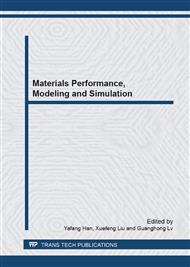p.392
p.401
p.407
p.414
p.421
p.425
p.432
p.437
p.444
Effect of Alterative and Homogenization on the Microstructure of Cu-20Ni-5Sn Alloy
Abstract:
The serious dendritic segregation occurs in Cu-20Ni-5Sn alloy. The microstructure of Cu-20Ni-5Sn alloy as-cast is composed of white light dendrite (Cu-Ni solid solution), Sn-rich solid solution (Cu2Ni3Sn3 phase) and block light precipitation (Ni17Sn3 phase). The microstructure of Cu-20Ni-5Sn alloy affected by alterative and homogenization temperature was studied. The results show that the alterative can refine the microstructures of the Cu-20Ni-5Sn alloy and reduce the segregation of Sn. The grains are quite fine with 0.9%Wt alterative in the alloy. The homogenization temperature of the Cu-20Ni-5Sn alloy decreases with increase of alterative content in the alloy. Grains enlarged with the increase of homogenization temperature, and the secondary phase distributes became more evenly. The optimization condition of homogenization treatment is at 800 in 24h.
Info:
Periodical:
Pages:
421-424
Citation:
Online since:
March 2013
Authors:
Keywords:
Price:
Сopyright:
© 2013 Trans Tech Publications Ltd. All Rights Reserved
Share:
Citation:


